1.
2.
3.
4.
5.
Experts divide the common cold into two broad categories - infectious and vasomotor. These categories include allergic and other types of rhinitis, classified in their composition. To know how to cure a lingering rhinitis in an adult, you need to understand that, depending on the nature and etiology of the disease, different methods of treatment are used. However, in pursuit of immediate relief, potent vasoconstrictor drops are often used, which disrupt the microflora and functionality of the nasal cavity.
Home Treatment of allergic rhinitis
Side Effects: Antihistamines can cause drowsiness and impairment of performance, which can lead to accidents and injuries. Even when these medications are taken just before bed, they can still cause significant damage the next day, even in people who do not feel sleepy.
For this reason, it is important that you do not drive or operate hazardous vehicles while taking a potentially sedative antihistamine. Some of the newer antihistamines do not cause drowsiness. A common side effect is excessive dryness of the mouth, nose, and eyes.
Why the runny nose does not go away
A runny nose may not stop for several reasons, and the main one is when the source of inflammation does not cease to exert its effect, and the mucous membrane continues to resist negative influence. Such a source of inflammation can be a bacteria, a virus (infectious-allergic form), an exogenous or endogenous allergen (allergy). Also, the reasons when the runny nose has dragged on are:
Less common side effects include agitation, nervousness, insomnia, dizziness, euphoria, fainting, blurred vision, decreased appetite, nausea, vomiting, abdominal pain, constipation, diarrhea, increased or decreased urinary retention, high blood pressure or low blood pressure. Nightmares, sore throat, abnormal bleeding or bruising, chest tightness, or palpitations.
Immunotherapy may be recommended for people who do not respond well to drug treatment or who have side effects from medications that have an allergen that are unavoidable or who want a more permanent solution to their allergy. Immunotherapy can be very effective in treating allergic symptoms, but it does not help the symptoms caused by non-allergic rhinitis.
- protective function of the nose for poor ecology;
- Excessive use of vasoconstrictor drops led to drying out of the mucous membrane and the development of chronic rhinitis;
- The nasal mucosa is inflamed or damaged due to atrophic processes;
- Mechanical, thermal, or chemical damage to the nasal cavity.
If you start treatment, or use the wrong medications, then both infectious and catarrhal rhinitis can become chronic, which is already much worse for treatment. Therefore, in order not to start the process on its own or not to evade the wrong self-medication, let's look at each type of rhinitis separately and find out how to deal with it.
The definition of rhinitis is symptoms caused by irritation or inflammation of the nose. The symptoms of rhinitis are the result of an obstruction or nasal congestion. Runic nose Itching Sneezing Clogged nose. ... These symptoms are the natural response of the nose to inflammation and irritation. They are most commonly associated with itchy eyes.
The mucus present in the nose serves to trap aggressive external substances and microbes. The mucus flows through the nose and down the back through the throat. When mucus production is too intense, it can cause a nasal discharge through the nostrils or a posterior nasal discharge through the throat.
In both catarrhal and infectious rhinitis, sinusitis sometimes develops as a complication - perhaps the most unpleasant consequence of a prolonged rhinitis. Self-treatment of sinusitis is fraught with consequences. You should consult your doctor if you suspect this ailment.
Sinusitis occurs when mucus that has accumulated in the sinuses has no outlet and remains in the human body. This mucus gradually turns into pus and then, having an excellent environment for the reproduction of bacteria, poisons the body with toxins. Then the body temperature rises and the nasal congestion becomes constant. Another symptom is a feeling of heaviness in the maxillary sinuses and persistent headaches. A particular danger to the disease is brought about by the factor that the maxillary sinuses (maxillary sinusitis) are in close proximity to the brain, eyes, and auditory system. Such a neighborhood can end tragically: by circulating through the lymph in the cranial regions, pus is able to enter the brain or other organs, provoking infection. Thus, meningitis and other dangerous illnesses can develop.
Coughing is a natural response to postnasal throat satiety. Itching, tingling, sneezing, and other symptoms can be a response to various causes. Allergic reactions chemical influences, including climate change, other factors. For most people, nasal congestion will target one side of the nose and the other for a cycle of several hours.
Some people may notice this nasal cycle more than others, especially if their nasal passages are narrow. Exercise or changes in head tilt can affect nasal congestion. Difficulty of nasal congestion can lead to pressure and pain on the face, as well as dark circles under the eyes.
Therefore, if you find yourself with the above symptoms, self-medication should be canceled and seek qualified help.
Infectious rhinitis

Infectious rhinitis develops when a pathogenic bacteria or virus enters the nasal mucosa. Most often, such an infection is not limited to the nasal cavity - very quickly, literally in a matter of hours, the infection can go down and multiply in the nasopharynx, trachea, bronchi. Such colonization of microbes causes inflammation of the mucous membrane in an attempt to free the walls of these organs from harmful foreign elements. The body's defensive reaction in this case is the secretion of mucus, which we call a cough and a runny nose.
In the absence of any specific treatment for chronic rhinitis, the goal is to reduce symptoms, prevent or reduce the risk of exposure to irritants or allergens, and use good nasal hygiene. After diagnosis allergic rhinitis treatment does not include exposure to allergens, drugs, and immunotherapy.
Grass pollen is so small that the wind can carry it miles from its source.
- Do not expose.
- One herb can release 1 million pollen grains in one day.
Thus, a runny nose is an attempt to rid the body of foreign elements by flushing them out of the nasal passages with mucus.
If, due to any infection, the runny nose has dragged on and does not go away for a long time, we are talking about a complication when acute form rhinitis became chronic. The consequence of this complication is a long, long-lasting runny nose.
While it is difficult or nearly impossible to avoid pollen and mold, here are some tips to reduce your exposure. Close windows if necessary and use an air conditioner in summer if possible. Outdoor air tends to become more concentrated in pollen and mold from 5am to 10am, limiting outdoor activity during these hours. Wear a pollen mask when mowing your lawn, collecting leaves or gardening and taking preventative treatment. Nasal hygiene - If non-exposure measurements are insufficient to produce symptoms, this may be the answer to strict nasal hygiene. Many doctors recommend using isotonic solutions to gently flush the nasal mucous membranes and eliminate discharge.
- Prefer air conditioning when driving.
- Do not dry your laundry outdoors.
- The pollen can be attached to towels and sheets.
Treatment of lingering rhinitis in adults in this situation is accompanied by a mandatory procedure for regular rinsing of the nose with saline. You can purchase a ready-made solution - often the Aqualor product is purchased for this purpose - or you can prepare it manually.
in order to independently prepare a means for washing the nose, it is necessary to mix the components - salt and water - in a ratio of 1 teaspoon to 1 liter of boiled water.
It is highly recommended that you add topical, immunostimulating treatment in a general way to your treatment for 2 months. Sinusitis is inflammation or infection of one of the four sinus cavities located in the skull that open into the nasal passages. Sinusitis must be distinguished from rhinitis, although both can be related and their symptoms can be similar. The terms "sinus problems" or "sinus congestion" are sometimes used incorrectly to refer to nasal congestion.
What is allergic rhinitis? Allergic rhinitis occurs in two different forms. They usually cause allergic sensitivity to pollen from trees, grasses or weeds, or mold spores in the air. Chronic: People with chronic allergic rhinitis have symptoms for a year. Food allergies Chronic symptoms rarely occur in general or in masks.
Such a solution will help the discharge from the nose to cope with its task of flushing out foreign elements. In the case when we are talking about allergic rhinitis, then we are talking about the fact that the immune system thus reacts to plant pollen, dust and other irritants. In this case, you should move away from flowering plants, carry out wet cleaning and take an antihistamine. If no allergen is identified, an immunological test should be performed.
Some people may be prone to both types of rhinitis, with more severe chronic symptoms during the pollen seasons. There may also be non-allergic causes of rhinitis. What causes sneezing, stinging eyes, and other symptoms? When a sensitive person inhales an allergen such as ragweed pollen, the body's immune system reacts abnormally.
The pollen “activates” these cells in the nasal mucosa, causing them to release histamine and other molecules. Histamine dilates the small vessels of the blood-thinning nose and flows into other tissues. This causes the nose to run, watery eyes, itching, swelling, and other allergy symptoms.
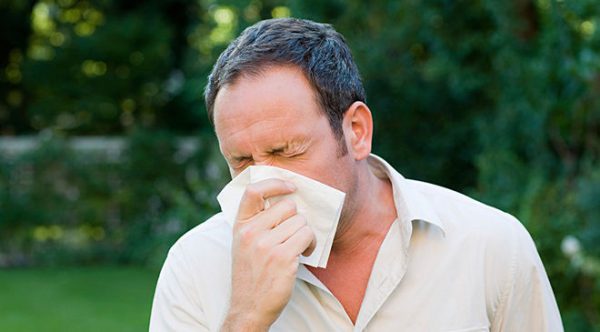
Along with the use of saline, various types of herbs are used, which also have a positive effect if the recovery is delayed and the runny nose worries:
- Aloe or Kalanchoe juice is used for nasal congestion, as it promotes the production of additional mucus. These plants also reduce inflammation and soothe mucous membranes. The juice should be extracted fresh from plants and immediately instilled a few drops into each nostril;
- Essential oils of eucalyptus, juniper, pine, fir are great for inhalation or aromatherapy. You should drop a few drops of oil on the aroma lamp and inhale the evaporating aroma. This procedure will remove inflammation, disinfect the sinuses and make breathing much easier;
- An infusion of chamomile flowers, sage, birch leaves, and oak bark helps to cure a prolonged runny nose. They can be drunk instead of tea, buried in the nose, and breathed in vapors over a container with hot infusion.
Compresses and warming are also used: heat salt in a pan, pour it into a sock and apply the resulting bag to the sinuses. You can use a freshly boiled chicken egg for heating. Warming up should be done every day for at least a week before bedtime. You should also contact the polyclinic to be recorded for physiotherapy procedures to warm up the maxillary sinuses.
Antibodies circulate in the bloodstream and accumulate in the tissues of the nose and skin. No fever, so why hay fever? Hay fever is a secular term that describes the symptoms of allergic rhinitis, especially when it occurs at the end of the summer season.
However, the symptoms are not caused by hay and are not accompanied by fever. Thus, the term "allergic rhinitis" is the most appropriate term. Likewise, spring allergy symptoms are sometimes referred to as “pink fever,” but this is just a coincidence between rose bloom and grass pollination. Roses and other fragrant, ornamental flowers are used by bees, not the wind, for pollination. A tiny fraction of their pollen is released into the air and is likely to cause allergies.
The consequences of infectious rhinitis can lead to atrophic rhinitis - when bacteria have a local aggressive effect. In this case, local antibiotics will be needed to eliminate them - for example, "Polydex". Symptoms of atrophic rhinitis are foul-smelling green crusts in the nasal passage, mucus becomes green and has an unpleasant odor.
Frequently asked question by people with allergic rhinitis. Allergists rarely recommend moving to prevent the risk of developing allergies. A person can avoid being allergic to ragweed, for example to increase susceptibility to herbs or other allergens in their new location.
Could allergic rhinitis have other effects on the body? Some well-known complications include ear infections, sinusitis, chronic sore throat, cough, headaches, sleep disturbances, fatigue, and irritability. Sometimes, children can develop facial growth modification and orthodontic problems.
Vasomotor rhinitis
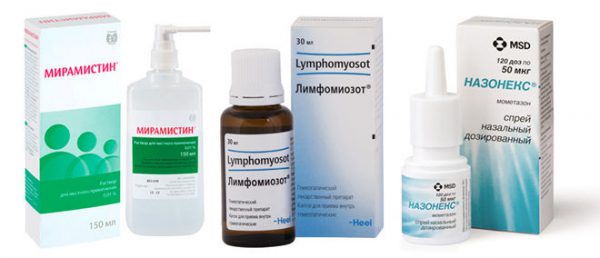
A runny nose that does not have an infectious origin is called vasomotor. This disease occurs when the tone of the blood vessels is disturbed. Such a runny nose is chronic.
To understand how to treat a lingering rhinitis of a non-infectious origin, you need to understand its causes. Vasomotor rhinitis can be:
Is rhinitis always caused by allergies? Rhinitis can result from many reasons other than allergies. All rhinitis symptoms are not necessarily the result of allergies. Here is a list of the top three causes of rhinitis and their characteristics. Type of rhinitis: infectious Common name: cold or flu Allergic sensitivity: none Causes: virus Duration of symptoms: three to seven days, sometimes longer. The most common rhinitis is the common cold, infectious rhinitis. Most infections are relatively short-lived, with symptoms of improvement at the end of three to seven days.
- neurovegetative;
- allergic.
Neurovegetative rhinitis is when common irritants - such as an unfavorable environment, gas pollution - cause a sharp reaction from the nasal mucosa. This type of rhinitis is non-allergic, since no allergens are detected in this form of rhinitis.
Although people sometimes do not betray the importance when they have a violent reaction of the nasal mucosa to cold air, or a strong smell, this disease requires compulsory treatment. This disease, if it does not go away for a long time, is associated with endocrine disorders in the body, or with functional changes in the central nervous system, and in order to find out the cause, you should go to an endocrinologist and a neurologist.
The common cold can be caused by over 200 viruses. Children, especially young children attending school or nursery, can contract eight to twelve colds a year. Colds usually begin as a congestion, followed quickly by a runny nose and sneezing. In the following days, the congestion worsens, the nasal mucus is purulent, and there may be a slight fever and cough. The cold symptoms disappear after a few weeks, but the cough can sometimes persist. Cold symptoms that persist can be caused by other causes, such as non-infectious rhinitis or sinusitis.
But a runny nose can be delayed for less serious reasons - neurovegetative rhinitis sometimes develops during pregnancy, after a severe flu, in children during teething, and for other reasons. In this case, such a runny nose sometimes goes away on its own. However, one should not rely on "maybe" and it is better to seek advice from the attending physician.
What are other causes of rhinitis? Hay fever symptoms are not all caused by allergies or infections. Similar symptoms can be caused by mechanical blockage, the use of certain drugs, irritants, climatic changes, or other mechanical factors. In fact, over a third of people with nasal symptoms do not have allergies during the year.
Narcotic congestion caused by medicinesmay be caused by birth control pills, certain medications for hypertension, and prolonged use of a nasal decongestant. Nasal decongestant sprays are quick and effective, but they seriously alter the normal functioning of the nasal passages. After several weeks of use, the tissue swells constantly. The use of these sprays can provide immediate relief, but the drug's effect is short-lived.
Allergic rhinitis is the body's reaction to pollen or other elements. Such a reaction of the body causes a lot of inconvenience to a person, as it is accompanied by nasal congestion, sneezing, watery eyes. These symptoms sometimes cause irritation and distraction. Fortunately, a huge number of antihistamines have been developed that can alleviate or completely relieve the symptoms of an allergic rhinitis.
More seriously, they cause irreversible damage to the nasal passages. It is then medicinal rhinitis. Medical advice and medication to "wean" a nasal decongestant for aerosols is often necessary. Cocaine also alters the normal functioning of the nasal passages, causing the condition to be the same or more severe than when using a decongestant nasal aerosol.
What Causes Non-Allergic Rhinitis? Non-allergic rhinitis or vasomotor rhinitis defines all other causes of rhinitis and symptoms not caused by infection or allergy. Many people have chronic nasal congestion, excessive mucus production, itching, and other nasal symptoms similar to those of allergic rhinitis, but the dysfunction is not caused by allergies.
Vasomotor rhinitis is the most common cause of lingering rhinitis in an adult and its treatment should be accompanied by hardening of the body, frequent spending time in the fresh air, and healthy eating.
Why you can't use vasoconstrictor drops for more than 5 days
Swelling of the mucous membrane during a runny nose has a protective function, since with the help of capillaries in the risk zone, blood flow is increased in order to deliver immune resources from the blood to fight the disease. All this complex work of the body leads to the fact that our nose does not breathe. This is especially painful during sleep.
To alleviate the condition, a number of nasal drops are used, which bring the vessels to their previous state with the help of their spasm and free the nasal passage for breathing. They are called vasoconstrictors - these are "Naphtizin", "Galazolin" and many others. The vascular wall of the nose, after such drops, becomes dry, which violates the algorithm of protective properties. Together with weakened blood flow, a sufficient amount of immune substances from the blood does not get to the site of inflammation in the nose, which weakens the body's ability to cope with the disease.
The consequence of such an influence is a prolonged runny nose in an adult, since the infection no longer meets with resistance. In addition, mucus, which is needed to flush out harmful substances, also ceases to be produced in sufficient quantities due to mucous membranes dried by drops and their impaired secretion.
The vessels become thinner, become fragile, which leads to nosebleeds. Such an effect of drops, provided they are used frequently, disrupts their natural regulation and can cause neurovegetative rhinitis. In addition, with prolonged and frequent use (more than 4-6 times a year, more than 5 days), such drops are addictive and cease to remove the symptom of nasal congestion.
Conclusion
In order not to fall for advertising of vasoconstrictor drugs and get a chronic rhinitis, as well as when a runny nose in an adult is delayed for other reasons, you should know how to cure a lingering rhinitis that occurs in an adult at home, and when you should immediately consult a specialist.
While looking harmless, a runny nose is still a lot of trouble and can undermine health, so this problem cannot be ignored. Be sure to use the tips of our article on eliminating a cold and do not get sick.
How to treat a lingering rhinitis in an adult?
- Varieties of pathology
- Types and causes of rhinitis
- Infectious rhinitis
- Allergic rhinitis
- Medicinal rhinitis
- Atrophic rhinitis
- Vasomotor rhinitis
- Specific types of rhinitis
In the modern world, a prolonged runny nose in an adult is a fairly common phenomenon. In addition to difficulty breathing, this condition can be accompanied by purulent or transparent secretions from the nose, itching, dryness, headaches, watery eyes and other unpleasant symptoms. Few people have not experienced a runny nose, especially in the cold season. Common cold with correct treatment and a strong immune system passes on average in a week. If the symptoms and manifestations of rhinitis show themselves for a longer period (weeks or months), you should seek professional help. After all, this may no longer be just a slight malaise, but one that can acquire a chronic form, therefore, it is necessary to find out its cause and take measures aimed at recovery.

Varieties of pathology
Prolonged rhinitis can be caused by a wide variety of causes, ranging from seasonal allergies to improper treatment of infectious diseases. The following types of rhinitis are distinguished:
- infectious;
- allergic;
- drug;
- atrophic;
- vasomotor.
Any form of rhinitis can become chronic in the absence of timely and correct treatment.
Long-term difficulty in breathing leads to shortness of breath, the onset and progression of symptoms bronchial asthma... This is a serious condition that requires a long and versatile treatment, therefore, with prolonged rhinitis, the obligatory help of an otolaryngologist, allergist and pulmonologist is necessary. Self-medication in this case is unacceptable, as it can lead to more serious consequences.
A separate category of diseases associated with the common cold includes psychosomatic rhinitis, which has not physiological, but psychological causes and is a consequence of various mental disorders. In this case, the help of a professional psychotherapist is already needed, who will offer alternative medicine and various types of psychotherapy as treatment.
Back to the table of contents
Types and causes of rhinitis
Back to the table of contents
Infectious rhinitis
A runny nose is a visiting card of many diseases caused by infections of a viral or bacteriological nature. Sore throats, sinusitis, tonsillitis, sinusitis are not a complete list of diseases accompanied by a runny nose. Under unfavorable conditions, the symptoms of the disease can become chronic.
Back to the table of contents
Allergic rhinitis
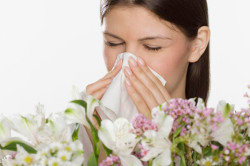 Allergy is the leader among the causes of prolonged lingering rhinitis in adults.
Allergy is the leader among the causes of prolonged lingering rhinitis in adults.
In severe cases, symptoms can persist all year round, causing a lot of inconvenience to patients.
The human environment contains a huge amount of allergens (pollen, household dust, chemical substances, animal hair), and with a decrease in the protective function of the immune system, an allergy may appear, accompanied by a runny nose, nasal congestion, sore eyes, lacrimation and headaches.
A progressive allergy can lead to the development of bronchial asthma.
Back to the table of contents
Medicinal rhinitis
A runny nose can occur as side effect taking certain medications, as well as being the result of abuse vasoconstrictor drops... Taking drops for nasal congestion has severe limitations that patients often neglect. So, using vasoconstrictor drugs more than 3-5 days addictive to the nasal mucosa. After the drug is discontinued, the mucous membrane swells even more than at the onset of the disease, which leads to a new round of taking drops. Addiction leads to a gradual increase in dose and chronic edema, proliferation of mucous membranes, which can only be dealt with by surgery.
Back to the table of contents
Atrophic rhinitis
 Atrophic rhinitis can be caused by both external harmful effects (unfavorable ecological environment) and congenital, hereditary factors.
Atrophic rhinitis can be caused by both external harmful effects (unfavorable ecological environment) and congenital, hereditary factors.
The disease is characterized by thinning or proliferation of the mucous membrane, its atrophy, loss of smell, in certain cases - a fetid odor from the nasal sinuses.
With atrophic rhinitis, conservative or surgical treatment is necessary.
Back to the table of contents
Vasomotor rhinitis
The causes of vasomotor rhinitis are not yet fully understood. It is believed that a runny nose is a violation of the tone of the vessels in the nasal cavity. As a result of vigorous activity nerve endings parasympathetic nervous system, blood vessels overflow, causing swelling of the nasal mucosa. These symptoms can worsen when a person goes out into the cold, when inhaling strong odors, with increased emotional stress and stress.
Back to the table of contents
Specific types of rhinitis
Also, a long course of rhinitis can be due to:
- Congenital diseases and abnormalities.
The most common congenital causes of rhinitis are the curvature of the nasal septum and malformation of the facial part of the skull, deformation and enlargement of the turbinates.
- Getting injured.
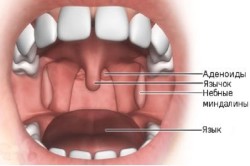 In this case, rhinitis is caused by physiological edema and tissue deformation, fractures of the bones of the nose and bridge of the nose. Lack of medical attention and surgical correction for nasal injuries can lead to a lingering rhinitis.
In this case, rhinitis is caused by physiological edema and tissue deformation, fractures of the bones of the nose and bridge of the nose. Lack of medical attention and surgical correction for nasal injuries can lead to a lingering rhinitis.
- Pathological enlargement of the nasopharyngeal tonsil (adenoiditis).
The enlargement of the pharyngeal tonsil is caused by the proliferation of lymphoid tissue. At the same time, the nasal entrances are blocked, congestion occurs, and normal air access is limited. According to statistics, this pathology is most often diagnosed in children, but cases of overgrowth of lymphoid tissue in adults are not uncommon.
- Benign growth of the mucous membrane (polyps in the nose).
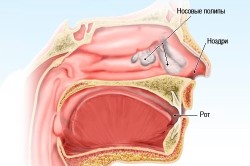 With prolonged inflammation of the nasal mucosa and the absence of treatment for the underlying disease, the tissues of the mucosa can grow and thicken. In this case, polyps can grow quite large and block the nasal passages, preventing the flow of air. This is common reason prolonged runny nose in adults.
With prolonged inflammation of the nasal mucosa and the absence of treatment for the underlying disease, the tissues of the mucosa can grow and thicken. In this case, polyps can grow quite large and block the nasal passages, preventing the flow of air. This is common reason prolonged runny nose in adults.
- The presence of any disease, a symptom of which is a lingering rhinitis.
One of these diseases is hypothyroidism - a decrease in the function of the thyroid gland, in which the human body suffers from a lack of hormones and swelling of the connective tissues, including the nasopharynx, occurs. You can identify the disease by taking a blood test for the level of thyroid hormones. Other diseases associated with nasal congestion include:
- rheumatoid arthritis;
- scleroderma;
- psoriasis;
- sarcoidosis;
- cystic fibrosis;
- wegener's granulomatosis;
- Kartagener's syndrome.
To prevent the transition of a simple rhinitis into a chronic form, you need to monitor your health, follow the instructions of your doctor and temper the body in every way. The benefits of vocal exercises for adults, breathing exercises, walks in the forest and the seaside have been proven. It is better to replace the instillation of vasoconstrictor drops with a procedure for rinsing the nose with infusions of medicinal herbs (after consulting an ENT doctor and in the absence of allergies) or inhalation. When treating a common cold, it is important to make an accurate diagnosis. Often, the cure of the underlying disease leads to the disappearance of the symptoms of rhinitis.
